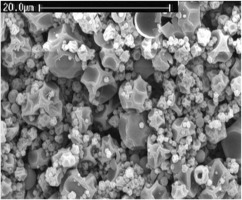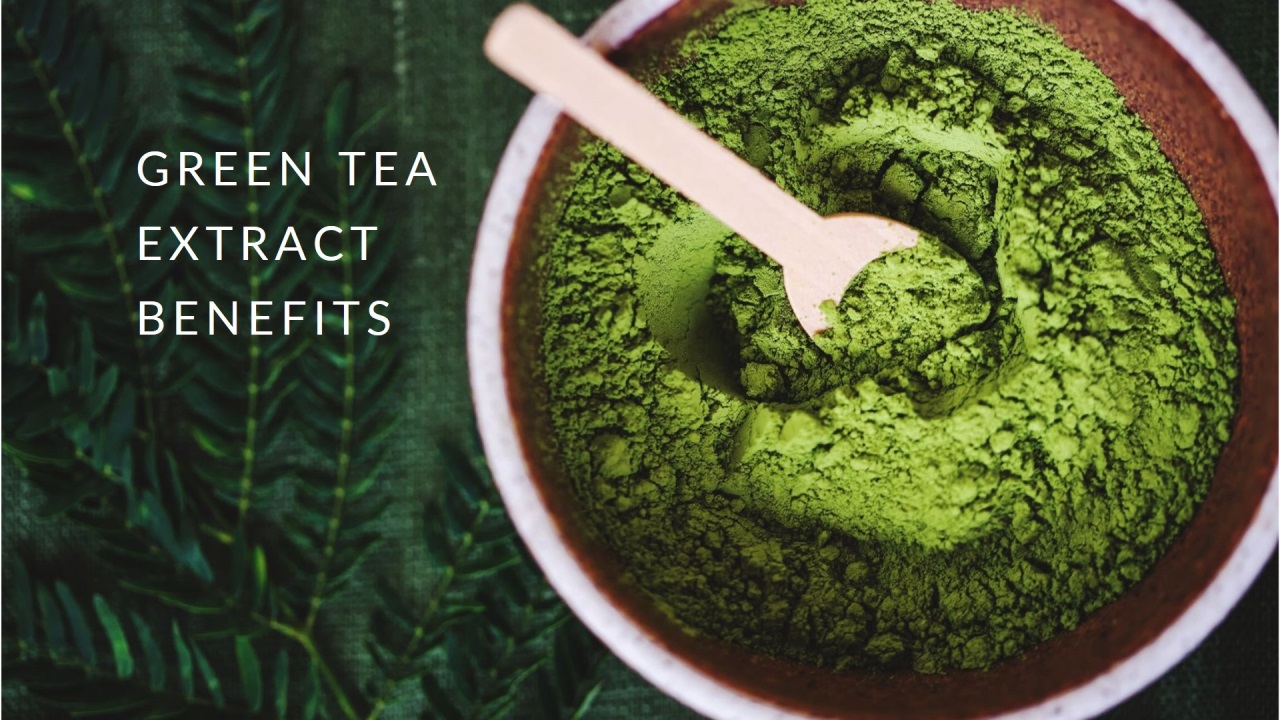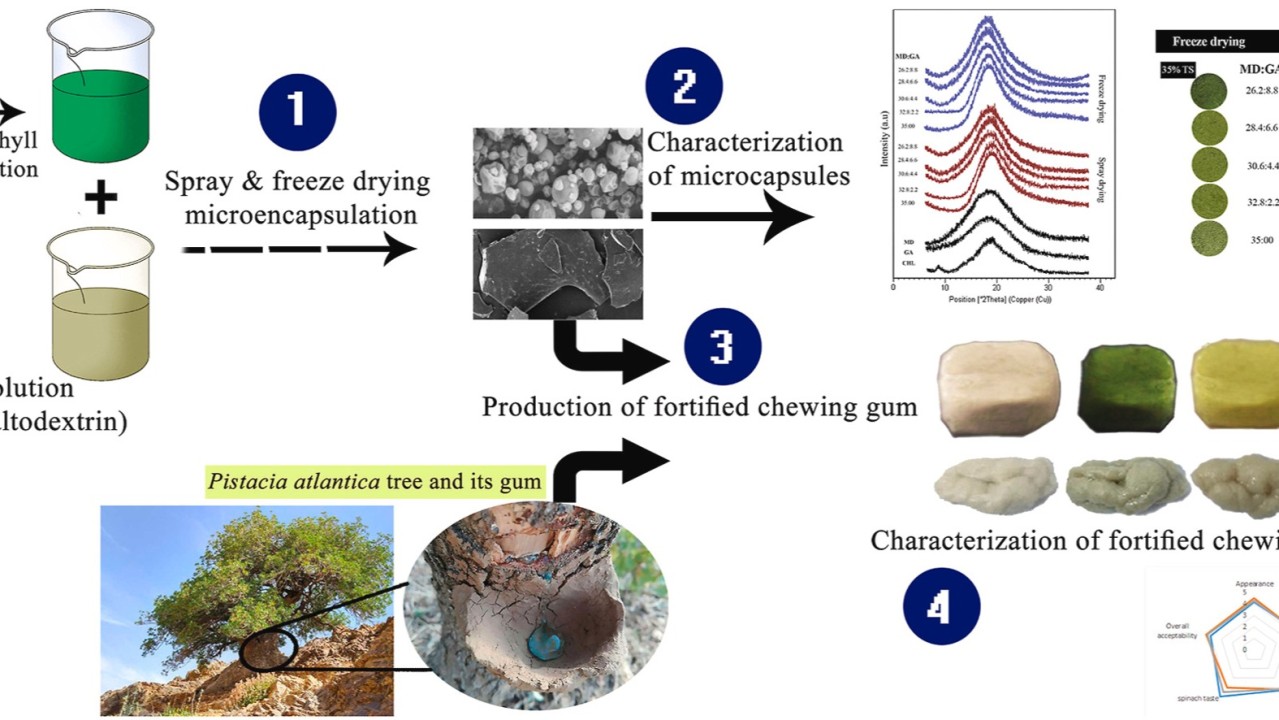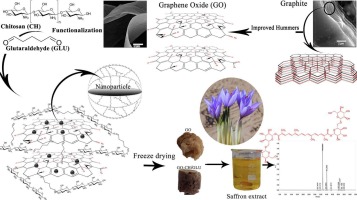Highlights
-
Saffron bioactive components were encapsulated using different wall materials.
-
A mixture of maltodextrin, Arabic gum and gelatin resulted in highest encapsulation efficiency.
-
Total solids significantly affected microcapsule properties and saffron components retention.
-
Over 80% retention of crocin, picrocrocin and safranal was achieved during spray drying encapsulation.
Hamid Rajabi a, Mohammad Ghorbani a,
Seid Mahdi Jafari a, Alireza Sadeghi Mahoonak a,
Ghadir Rajabzadeh b
- a
- Department of Food Materials and Process Design Engineering, University of Agricultural Sciences and Natural Resources, Gorgan, Iran
- b
- Research Institute of Food Science and Technology, Mashhad, Iran
Received 22 February 2015, Revised 25 May 2015, Accepted 27 May 2015, Available online 5 June 2015, Version of Record 12 June 2015.
Abstract
Saffron as the world’s most expensive spice is very sensitive and loses its active compounds in exposure to environmental conditions. In this work, microencapsulation of saffron extract by various biopolymers was studied as an effective way to preserve its active compounds. Emulsions with a constant ratio of saffron extract/wall material of 1:20 and two levels of total solids (TS of 30 and 40%), were prepared using a homogenizer, and then spray dried. Powders were characterized in terms of powder yield, encapsulation efficiency, and retention of saffron active components, microstructure, and moisture content. Retention of picrocrocin, safranal and crocin after spray drying was analyzed by measuring absorbance at 257, 330 and 440 nm, respectively. It was observed that a mixture with 40% TS consisting of maltodextrin, gum Arabic and gelatin in the weight ratio of 0.94:0.05:0.01 retained the highest amount of picrocrocin, safranal and crocin, by retention values of 90.06, 80.37, and 91.03%, respectively. Both encapsulation efficiency and powder yield were positively influenced by total solids content, which could be related to the emulsion viscosity and droplet size. To conclude, a mixture of maltodextrin, gum Arabic and gelatin was efficient for saffron extract encapsulation by spray drying.
Graphical abstract
SEM of spray-dried saffron microcapsules at 30% TS with MD–GA–GE (85:10:5).

Introduction
Saffron from about 3000 years ago has been cultivated and used because of its unique features (Deo, 2003). Saffron, the dried and colored-red stigma of Crocus sativus L., belongs to the Iridaceae family, and is produced largely in Asia (particularly Iran) (Fernández and Pandalai, 2004, Kafi et al., 2006, Khazaei et al., 2014, Xuabin, 1992). Today, saffron has found many uses ranging from fragrances to dyes and medicines (Melnyk, Wang, & Marcone, 2010). In recent years, despite of its high price, the use of saffron is steadily increasing, due to changes of consumer preference towards natural products having functional properties (Knewstaubb & Henry, 1988).
Three main active compounds identified in saffron are crocin, picrocrocin and safranal (Carmona et al., 2006, Nassiri-Asl and Hosseinzadeh, 2014, Tarantilis et al., 1994) which lose their nature when exposed to light, heat and oxygen. Crocin and picrocrocin undergo to oxidation and hydrolysis reactions; meanwhile safranal, which causes the fragrance in saffron, is volatile at ambient temperatures. Therefore, encapsulation of saffron extract could result in a powder with a longer shelf life.
Encapsulation is defined as a protective method for active compounds which are sensitive to environmental conditions (Ahmed et al., 2010, Borgogna et al., 2010, Jafari et al., 2008, Medina-Torres et al., 2013, Saénz et al., 2009). On the other hand, during encapsulation, active compounds are packaged within a matrix or membrane (Akhavan, Jafari, Ghorbani, & Assadpoor, 2014). Encapsulation of herbal products could improve process capability, easy maintenance and low cost delivery, protect against environmental conditions and improve final product qualities (Deladino et al., 2008, Shu et al., 2006).
Among several encapsulation techniques, spray drying is the effective and most common one in the food industry (Jafari et al., 2008, Pang et al., 2014, Ré, 1998, Reineccius, 2001, Reineccius, 2004, Shahidi and Han, 1993), and one of the oldest encapsulation methods. The method consists of liquid atomization into small droplets, a drying step carried out using a warmed gas and collection of the solid particles (Beck-Broichsitter, Schmehl, Seeger, & Gessler, 2011). Selection of appropriate wall materials is one of the main steps in microencapsulation process (Pang et al., 2014). Common microencapsulation agents such as gum Arabic (GA) and maltodextrin (MD) are often used for herbal or plant-related products (Bhusari et al., 2014, Fazaeli et al., 2012, Janiszewska, 2014, Şahin-Nadeem et al., 2013, Silva et al., 2014, Turchiuli et al., 2014). For instance, Khazaei et al. (2014) employed two biopolymers, namely MD and GA to microencapsulate the anthocyanins of saffron petals. Furthermore, Castro-Muñoz, Barragán-Huerta, and Yáñez-Fernández (2014) investigated the spray drying microencapsulation of clarified juice extracted from purple cactus pear using gelatin (GE) and MD.
There is no information available on microencapsulation of saffron extract by spray drying. Most of the works in literature deal with microencapsulation of colorants (Barbosa et al., 2005, Rocha et al., 2012, Shu et al., 2006), flavors (Baranauskienė et al., 2006, Bayram et al., 2005, Liu et al., 2004, Reineccius, 1988, Reineccius et al., 1995) or essential oils (Kanakdande et al., 2007, Rosenberg et al., 1990, Soottitantawat et al., 2004, Soottitantawat et al., 2005, Soottitantawat et al., 2003) alone, but saffron stigma has all three type of these ingredients and therefore, microencapsulation of its extract, is a complex process. Crocin is a water-soluble glycosidic carotenoid responsible for color, picrocrocin causes a bitter-taste and safranal is the main volatile oil present in saffron (Caballero-Ortega, Pereda-Miranda, & Abdullaev, 2007).
The objective of this work was to study the microencapsulation of saffron extract by spray drying with binary and ternary blends of MD, GA, and GE as wall materials. The microcapsules were evaluated for the retention of saffron active components, moisture content and encapsulation efficiency. Scanning electron microscopy was also used to observe the microstructural characteristics of encapsulated powders.
Section snippets
Saffron powder preparation
Saffron was picked before sunlight from a farm around Torbat-E-Heydariyeh (Iran). Stigmas were separated from the other part of flowers. In order to determine the optimal drying method, three methods were pre-investigated considering drying at room temperature (25 °C ± 1), dehydration with electrical oven (60 °C ± 1), and microwave drying (1000 W). Our results showed (data not given) that the highest content of saffron active components (SAC) was obtained when saffron treated at higher
Effect of TS on the retention of saffron bioactive components during encapsulation
The average values of encapsulation efficiency for SAC are shown in Fig. 1. With respect to the total solids content, this variable had a positive effect on the encapsulation efficiency, i.e., higher solids content resulted in higher encapsulation efficiencies. It is shown that the most important factor determining the retention of volatiles and encapsulation efficiency of food oils during spray drying is the dissolved solids content in the feed (Jafari et al., 2007a, Jafari et al., 2007b). Our
Conclusion
The present study describes the use of three types of wall materials i.e. maltodextrin, gum Arabic and gelatin for the microencapsulation of saffron extract using spray-drying technique. Total solids content had a positive influence on the encapsulation efficiency and the SAC retention. These results could be related to emulsion properties, mainly viscosity. Higher solids concentration leads to bigger particle sizes, lower moisture contents and higher powder yields. As far as the blends were
Acknowledgment
Iran National Science Foundation (grant number 90000994) and the Research Institute of Food Science and Technology should be acknowledged for their financial support.
References (89)
- M. Ahmed et al.
Encapsulation by spray drying of bioactive components, physicochemical and morphological properties from purple sweet potato
LWT – Food Science and Technology
(2010) - R. Baranauskienė et al.
Properties of oregano (Origanum vulgare L.), citronella (Cymbopogon nardus G.) and marjoram (Majorana hortensis L.) flavors encapsulated into milk protein-based matrices
Food Research International
(2006) - M. Barbosa et al.
Light stability of spray-dried bixin encapsulated with different edible polysaccharide preparations
Food Research International
(2005) - Ö.A. Bayram et al.
Spray drying of sumac flavour using sodium chloride, sucrose, glucose and starch as carriers
Journal of Food Engineering
(2005) - S. Bhusari et al.
Effect of carrier agents on physical and microstructural properties of spray dried tamarind pulp powder
Powder Technology
(2014) - M. Borgogna et al.
Food microencapsulation of bioactive compounds: rheological and thermal characterisation of non-conventional gelling system
Food Chemistry
(2010) - H. Caballero-Ortega et al.
HPLC quantification of major active components from 11 different saffron (Crocus sativus L.) sources
Food Chemistry
(2007) - Couto et al.
Spray drying of Eugenia dysenterica extract: effects of in-process parameters on product quality
Revista Brasileira de Farmacognosia
(2013) - L. Deladino et al.
Encapsulation of natural antioxidants extracted from Ilex paraguariensis
Carbohydrate Polymers
(2008) - S. Ersus et al.
Microencapsulation of anthocyanin pigments of black carrot (Daucus carota L.) by spray drier
Journal of Food Engineering
(2007) - C. Favaro-Trindade et al.
The use of spray drying technology to reduce bitter taste of casein hydrolysate
Food Hydrocolloids
(2010) - M. Fazaeli et al.
Effect of spray drying conditions and feed composition on the physical properties of black mulberry juice powder
Food and Bioproducts Processing
(2012) - L.P. Fernandes et al.
Spray drying microencapsulation of Lippia sidoides extracts in carbohydrate blends
Food and Bioproducts Processing
(2012) - E. Frascareli et al.
Effect of process conditions on the microencapsulation of coffee oil by spray drying
Food and Bioproducts Processing
(2012) - S.A. Hogan et al.
Emulsification and microencapsulation properties of sodium caseinate/carbohydrate blends
International Dairy Journal
(2001) - E. Janiszewska
Microencapsulated beetroot juice as a potential source of betalain
Powder Technology
(2014) - M. Jayasundera et al.
The effect of protein types and low molecular weight surfactants on spray drying of sugar-rich foods
Food Hydrocolloids
(2011) - N. Jinapong et al.
Production of instant soymilk powders by ultrafiltration, spray drying and fluidized bed agglomeration
Journal of Food Engineering
(2008) - D. Kanakdande et al.
Stability of cumin oleoresin microencapsulated in different combination of gum arabic, maltodextrin and modified starch
Carbohydrate Polymers
(2007) - S. Krishnan et al.
Microencapsulation of cardamom oleoresin: evaluation of blends of gum arabic, maltodextrin and a modified starch as wall materials
Carbohydrate Polymers
(2005) - S. Krishnan et al.
The use of gum arabic and modified starch in the microencapsulation of a food flavoring agent
Carbohydrate Polymers
(2005) - F. León-Martínez et al.
Spray drying of nopal mucilage (Opuntia ficus-indica): effects on powder properties and characterization
Carbohydrate Polymers
(2010) - Z.-q. Liu et al.
The enhancement and encapsulation of Agaricus bisporus flavor
Journal of Food Engineering
(2004) - L. Medina-Torres et al.
Microencapsulation by spray drying of gallic acid with nopal mucilage (Opuntia ficus indica)
LWT – Food Science and Technology
(2013) - J.P. Melnyk et al.
Chemical and biological properties of the world’s most expensive spice: saffron
Food Research International
(2010) - O. Orfanou et al.
Evaluation of the colouring strength of saffron spice by UV–vis spectrometry
Food Chemistry
(1996) - S.F. Pang et al.
Assessment of phenolic compounds stability and retention during spray drying of Orthosiphon stamineus extracts
Food Hydrocolloids
(2014) - G.A. Rocha et al.
Microencapsulation of lycopene by spray drying: characterization, stability and application of microcapsules
Food and Bioproducts Processing
(2012) - Rosenberg et al.
Microencapsulation of volatiles by spray-drying in whey protein-based wall systems
International Dairy Journal
(1996) - C. Saénz et al.
Microencapsulation by spray drying of bioactive compounds from cactus pear (Opuntia ficus-indica)
Food Chemistry
(2009) - H. Şahin-Nadeem et al.
Influence of inlet air temperature and carrier material on the production of instant soluble sage (Salvia fruticosa Miller) by spray drying
LWT – Food Science and Technology
(2013) - B. Shu et al.
Study on microencapsulation of lycopene by spray-drying
Journal of Food Engineering
(2006) - V. Silva et al.
Influence of different combinations of wall materials and homogenisation pressure on the microencapsulation of green coffee oil by spray drying
Food Research International
(2014) - Soottitantawat et al.
Influence of emulsion and powder size on the stability of encapsulated D-limonene by spray drying
Innovative Food Science & Emerging Technologies
(2005) - P.A. Tarantilis et al.
Separation of picrocrocin, cis–trans-crocins and safranal of saffron using high-performance liquid chromatography with photodiode-array detection
Journal of Chromatography A
(1994) - R.V. Tonon et al.
Influence of emulsion composition and inlet air temperature on the microencapsulation of flaxseed oil by spray drying
Food Research International
(2011) - C. Turchiuli et al.
Use of different supports for oil encapsulation in powder by spray drying
Powder Technology
(2014) - S. Akhavan et al.
Spray-drying microencapsulation of anthocyanins by natural biopolymers: a review
Drying Technology
(2014) - M. Ameri et al.
Spray drying of biopharmaceuticals: stability and process considerations
Drying Technology
(2006) - L.L. Balassa et al.
Microencapsulation in the food industry
Critical Reviews in Food Science & Nutrition
(1971) - M. Beck-Broichsitter et al.
Evaluating the controlled release properties of inhaled nanoparticles using isolated, perfused, and ventilated lung models
Journal of Nanomaterials
(2011) - J. Brenner
The essence of spray dried flavors: the state of the art
Perfumer and Flavorist
(1983) - M. Carmona et al.
Crocetin esters, picrocrocin and its related compounds present in Crocus sativus stigmas and Gardenia jasminoides fruits. Tentative identification of seven new compounds by LC–ESI–MS
Journal of Agricultural and Food Chemistry
(2006) - R. Castro-Muñoz et al.
Use of gelatin–maltodextrin composite as an encapsulation support for clarified juice from purple cactus pear (Opuntia stricta)
LWT – Food Science and Technology
(2014)
There are more references available in the full text version of this article.
Cited by (229)
-
Nanoencapsulation of carotenoids within lipid-based nanocarriers
2019, Journal of Controlled Release -
Nano spray drying for encapsulation of pharmaceuticals
2018, International Journal of Pharmaceutics -
Microencapsulation optimization of natural anthocyanins with maltodextrin, gum Arabic and gelatin
2016, International Journal of Biological Macromolecules -
Nano-encapsulation of saffron extract through double-layered multiple emulsions of pectin and whey protein concentrate
2015, Journal of Food Engineering -
Advances in Spray-Drying Encapsulation of Food Bioactive Ingredients: From Microcapsules to Nanocapsules
2019, Annual Review of Food Science and Technology



